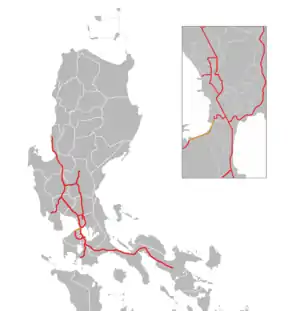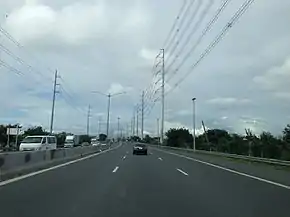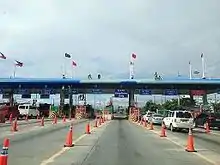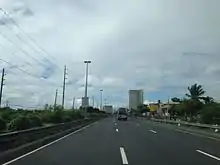Manila–Cavite Expressway
The Manila–Cavite Expressway, also known as Coastal Road, CAVITEX and R-1 Expressway,[2] is a 14-kilometer-long (8.7 mi) limited-access toll expressway linking Manila to the southern province of Cavite in the Philippines. The entire expressway is designated as Expressway 3 (E3) of the Philippine expressway network and forms part of Radial Road 1 (R-1) of Manila's arterial road network. It is owned by the Public Estates Authority Tollway Corporation (PEATC), a government corporation and subsidiary of the Public Estates Authority, a government agency under the Office of the President, and is operated by Cavite Infrastructure Corporation, a unit of Philippine-based company Metro Pacific Investments Corporation (MPIC).[3]
.svg.png.webp) R-1 CAVITEX | ||||
|---|---|---|---|---|
| Coastal Road R-1 Expressway Aguinaldo Boulevard Manila–Cavite Coastal Road | ||||
 Map of expressways in Luzon, with the Manila–Cavite Expressway in orange | ||||
 CAVITEX looking northbound near Zapote, Las Piñas | ||||
| Route information | ||||
| Maintained by Cavite Infrastructure Corporation | ||||
| Length | 14.0 km (8.7 mi) | |||
| Existed | 1998[1]–present | |||
| Component highways | ||||
| Restrictions |
| |||
| Major junctions | ||||
| North end | ||||
| ||||
| South end | ||||
| Location | ||||
| Provinces | ||||
| Major cities | ||||
| Towns | Kawit | |||
| Highway system | ||||
| ||||
At the north end, it feeds into and from Roxas Boulevard in the city of Parañaque in Metro Manila, also part of R-1. At the south end, it splits into two termini, both along the north coast in Kawit, Cavite. One feeds into the intersection of Tirona Highway and Antero Soriano Highway. Left backtracks through Binakayan back to Bacoor, straight proceeds on Soriano towards the Cavite Economic Zone, and right proceeds towards the expressway's other terminus on the intersection of Tirona Highway and Antero Soriano Highway near the Aguinaldo Shrine heading towards Noveleta, Cavite.
In 2011, the extension to Kawit was opened to the public. In 2015, the C-5 Road was extended south to connect to the northbound lanes of the expressway in Las Piñas. Since December 2016, the expressway also links to the elevated NAIA Expressway (NAIAX) at its north end providing access to the Ninoy Aquino International Airport and Skyway. It will be the street alignment of the Manila LRT-1 South Extension when completed in Parañaque. It will have 2 stations, namely: Asia World and Manila International Airport.
The expressway features a limited number of interchanges. The original south terminus of the expressway in Bacoor has been converted into a full trumpet interchange. There are two toll barriers on the expressway: the original barrier in Parañaque and the extension barrier in Kawit. The expressway also features a one-way mini toll booth feeding into the expressway from Quirino Avenue, Parañaque. Vehicles are charged a flat toll rate based on class. PEATC has also incorporated a near-field communication prepaid card it calls E-TAP. The Expressway also now accepts an electronic toll collection system called Easytrip RFID, which currently manages ETC for the North Luzon Expressway, Subic–Clark–Tarlac Expressway, and Cavite–Laguna Expressway.[4]
Route description
_extension_(Zapote%252C_Bacoor%252C_Cavite%253B_2017-04-03)_(cropped).jpg.webp)
The Manila–Cavite Expressway follows a mostly curving route of the shore of Manila Bay, and the Bacoor–Kawit extension is built on reclaimed land near the coastal barangays of Bacoor. The road uses a barrier toll system, which involves toll barriers at entry points and no toll collection at the exit points, except at the Kawit and Parañaque toll plazas. The expressway is a physical extension of Roxas Boulevard. Lane count is usually 3 lanes for the NAIA Road–Bacoor section, the original route of the expressway known as Coastal Road, and 2 lanes at the Bacoor–Kawit segment, that forms the Kawit extension of the expressway. Various high voltage power lines, most notably the Dasmariñas–Las Piñas Transmission Line of National Grid Corporation of the Philippines (NGCP), utilize the expressway right of way from its Las Piñas substation to Bacoor Exit for accessibility to work vehicles and also due to scarcity of land for dedicated right of way.
The expressway starts at the traffic light intersection with NAIA Road, Roxas Boulevard, and New Seaside Drive, near Uniwide Coastal Mall. Past the intersection is an eastbound entrance and westbound exit of NAIA Expressway, opened in 2016. The only at-grade intersection of the expressway then comes at its intersection with Pacific Avenue, where southbound motorists are also carried by the Pacific Avenue flyover. An entry point to the northbound from the Kabihasnan area of Parañaque is found before the approach to the Parañaque toll plaza. The expressway widens on approach to the Parañaque toll plaza, where tolls for southbound motorists are collected. After Parañaque toll plaza is a right-in/right-out interchange with the Circumferential Road 5 (C-5) Extension, which is accessible only from the northbound direction. The expressway then enters the province of Cavite and passes Bacoor Exit, the original end of the expressway at Bacoor, where the original alignment involved a curve that was changed to a full interchange with the opening of the Kawit extension. CAVITEx past Bacoor Exit becomes a four-lane dual carriageway on reclaimed land built on the shores of seaside barangays of Bacoor. The expressway widens at approach to the Kawit toll plaza, where the end of the expressway is moved from the opening of the Kawit extension in 2011. The terminus at Kawit is a box intersection with Tirona Highway, Covelandia Road, and Antero Soriano Highway, which is the physical extension of the existing expressway. The end of the expressway at Kawit will accommodate the Cavite end of the under-construction Cavite–Laguna Expressway.
History
Back in the 1970s, traffic congestion was a daily occurrence in the narrow stretch of land in Parañaque and Las Piñas going to nearby provinces, particularly Cavite. The Philippine government proposed a major road network that would link Roxas Boulevard to all other parts of Metro Manila and the Southern Tagalog provinces. This led to the construction of a 6.6-kilometer (4.1 mi), four-lane (two on each side) asphalt reclaimed road from Roxas Boulevard leading to the then-municipalities of Parañaque, Las Piñas, and Bacoor which opened in 1998.[1][5]
In 2011, a 7-kilometer (4.3 mi) extension to Kawit, Cavite, was opened.[1]
On December 28, 2016, the access ramps connecting Coastal Road and NAIA Expressway opened to motorists coming from Cavite and Las Piñas, for easier access to NAIA Terminals 1, 2, and 3 and vice versa.
The Pacific Avenue flyover, which was planned in 2016, started construction in 2017 and was expected to be complete by March 2018. However, due to difficulties in transporting equipment and the location of the flyover between the north end of the expressway and the Parañaque Toll Plaza, the completion date was moved to August 2018. The flyover eliminated the signalized intersection for vehicles bound for Diosdado Macapagal Boulevard via Pacific Avenue, and improve the traffic situation around the said intersection.
As of June 2018, the expressway is being expanded with the construction of additional lanes on the NAIA–Zapote segment.
Future
CAVITEx–C5 South Link
CAVITEx–C5 South Link Expressway is a 7.7-kilometer (4.8 mi), six-lane road which will connect C-5 Road from Taguig to CAVITEx.[6] It entails the construction of a 2.2-kilometer-long (1.4 mi) flyover between the C-5 Road in Taguig and the C-5 Road Extension in Pasay (near Merville, Parañaque) over the South Luzon Expressway and Skyway. The second phase includes the completion of the C-5 Road Extension from Merville to Las Piñas and the construction of an interchange with Coastal Road in Parañaque. It is a component of Expressway 2.[7][8]
The construction of the ₱9.5B CAVITEx–C5 South Link project started on May 8, 2016.[9][10] Phase 1 was opened to traffic on July 23, 2019 and completion of the project is expected in 2021.[11][12]
Segment 5 (Kawit to Rosario)
Metro Pacific Investments Corporation submitted a proposal to the Toll Regulatory Board to extend the expressway from Kawit to Rosario, Cavite. The 9.5-kilometer (5.9 mi) extension is estimated to cost ₱22.5 billion .[3][13]
Sangley Point extension
A proposal to extend the expressway to Sangley Point Airport in Cavite City was submitted to the Department of Public Works and Highways in 2017 by CAVITEx Holdings, Inc. The proposed project aims to construct a 4.63-kilometer-long (2.88 mi) viaduct.[14] Its cost is yet to be determined as it awaits approval from the government.[15]
Technical specifications
- Name: Manila–Cavite Expressway or CAVITEx
- Concession holder: Cavite Infrastructure Corporation
- Operator: Cavite Infrastructure Corporation
- Concession starting date: October 1, 1998[5]
- Concession ending date: September 30, 2033[5]
- Length: 14 km (8.7 mi)
- Highway exits: 3
- Lanes: 4 lanes (2 lanes each direction) (south portion from the Parañaque Toll Plaza) / 6 lanes (3 lanes each direction) (north portion from the Parañaque Toll Plaza)
- Toll plazas: 2
- Rest and Service Areas: none
- Minimum Height Clearance on Underpasses: Not applicable
Toll

The expressway uses a barrier toll system that uses toll barriers at entry points, where motorists pay a fixed toll rate. The two large toll plazas, such as those found in Parañaque and Kawit, and the Kabihasnan entry are the toll collection points for the expressway. There are no toll collection at the exit points, except at the Kawit and Parañaque toll plazas. The electronic toll collection (ETC) system on the expressway is operated by Easytrip Services Corporation and collections are done on both dedicated lanes and mixed lanes at the toll barriers.
Tolls are assessed in each direction at each barrier, based on class. In accordance with law, all toll rates include a 12% value-added tax.
| Class | Kabihasnan | Parañaque | Kawit |
|---|---|---|---|
| 1 | ₱8.00 | ₱25.00 | ₱64.00 |
| 2 | N/A | ₱50.00 | ₱129.00 |
| 3 | N/A | ₱75.00 | ₱194.00 |
Exits
Exits are numbered by kilometer posts, with Rizal Park in Manila designated as kilometer zero.
| Region | Province | City/Municipality | km | mi | Exit | Name | Destinations | Notes |
|---|---|---|---|---|---|---|---|---|
| Metro Manila | Parañaque | 8 | 5.0 | MIA Rd. | Northern terminus. Continues north as | |||
| 8.3 | 5.2 | Northbound exit and southbound entrance | ||||||
| 8.45 | 5.25 | Caltex service station (southbound only) | ||||||
| 10 | 6.2 | Pacific Avenue | Flyover interchange; No right turns from southbound lane. | |||||
| 13 | 8.1 | Kabihasnan | Northbound entrance only | |||||
| 13 | 8.1 | Southlink's R-1 Interchange; proposed trumpet interchange[17] | ||||||
| 13 | 8.1 | Parañaque Toll Plaza | ||||||
| Las Piñas | 14 | 8.7 | C-5 Road Extension | Incomplete right-in/right-out exit for C-5 Extension; Entrance only | ||||
| Calabarzon | Cavite | Bacoor | 15 | 9.3 | Bacoor (Longos) | Trumpet interchange; Former southern terminus | ||
| Kawit | 23 | 14 | Kawit Toll Plaza | |||||
| 24 | 15 | Marulas | Southbound exit only | |||||
| 24 | 15 | Binakayan (Zeus) | Southern terminus. Continues south as | |||||
1.000 mi = 1.609 km; 1.000 km = 0.621 mi
| ||||||||
Notes
References
- "Land Development". Philippine Reclamation Authority. Retrieved January 20, 2016.
- "Construction Begins on New Cavitex C5 Link Sections, Project Deal Inked". Cavite Expressway. Parañaque City. July 10, 2020.
- "MPIC unit eyes P22.5 billion Cavitex extension". The Philippine Star. Retrieved April 7, 2018.
- "Frequently Asked Question – Cavitex". Easytrip Services Corporation Philippines. Retrieved December 27, 2016.
- "Toll Road Projects: CAVITEX". Toll Regulatory Board.
- "C-5 South Link Project". Department of Public Works and Highways. Retrieved October 28, 2017.
- "Road and Bridge Inventory". Department of Public Works and Highways. Retrieved January 31, 2021.
- "NCR". Department of Public Works and Highways. Retrieved January 31, 2021.
- Amojelar, D.G. (February 1, 2017). "FF Cruz to build Cavitex C5 link". The Standard (Philippines). Retrieved February 7, 2017.
- Camus, Miguel R. (May 9, 2016). "Cavitex-C5 South Link Road project starts". Business. Philippine Daily Inquirer. Retrieved May 20, 2017.
- "Section of CAVITEX- C5 Southlink opens". ABS-CBN News. July 23, 2019. Retrieved June 7, 2020.
- "Taguig-Parañaque section of C5 South Link Expressway opens to motorists July 23". GMA News. Retrieved August 18, 2019.
- "Cavitex extension proposed". Manila Standard. April 12, 2018. Retrieved July 19, 2018.
- "MPIC proposes Cavitex-Sangley expressway". Manila Standard. August 6, 2017. Retrieved July 19, 2018.
- "Cavitex-Sangley Extension | Department of Public Works and Highways". www.dpwh.gov.ph. Retrieved July 19, 2018.
- "C5 South Link Project". Department of Public Works and Highways. Retrieved August 17, 2020.
- Valdez, Denise A. "C5 South Link phase 1 to open in 2nd quarter". Metro Pacific Tollways Corporation. Retrieved August 17, 2020.
